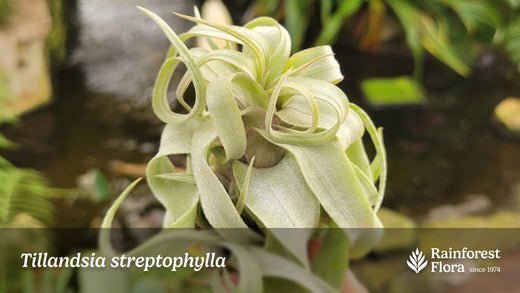
Notes from Tillandsia II: Tillandsia streptophylla
Share
When our co-founder, Paul Isley, wrote Tillandsia II, his meticulous catalogue of Tillandsia species, cultivars, and hybrids; we never could have guessed what a phenomenon it would become. Over the years we've heard from thousands of plant lovers about the impact Paul's book had on them and their journey into hobbyist or professional horticulture.
To celebrate the legacy of Tillandsia II, we will be sharing excerpts of the book here, one plant at a time. If you're new to the world of Tillandsia, we hope it will spark a lifelong love. –the Rainforest Flora Team
Tillandsia streptophylla
Scheideweiler; 1836
(strep-toe-FIH-la)
Subgenus: Tillandsia
Streptophylla is from the Greek. It is a combination of the adjective streptos, which means "twisted," and phyllon, which means "leaf."
Tillandsia streptophylla is a myrmecophyte that grows epiphytically from sea level to more than 800 meters in elevation, and its range extends from southern Mexico to Honduras. This is one of the few species to have evolved a nickname-the "Shirley Temple" plant. The leaves often twist and recurve in a manner that is Nature's imitation of the coiffed child of days gone by.
Interestingly, the grower can control the amount of curl in the leaves by the amount of water and humidity the plant receives. In a wetter, more humid environment the leaves grow straighter. With more xeric conditions, the leaves tighten into curled ringlets. Enthusiasts can be found who favor either style—it is purely a matter of personal preference as to how one wishes to grow this species. It varies in size; a small mature specimen is about 18 cm in width and height. Larger plants can grow to 60 cm although that's a stretch.
A plant that is dehydrated can be quickly hydrated by an overnight soaking in water—a pinch of fertilizer helps. The leaf cells will absorb any more. Oxygen and carbon dioxide gas exchange, so vital to a plant's metabolic activity, will not be adversely affected if interrupted for a day or so.
The leaf sheaths of Tillandsia streptophylla are broadly ovate or elliptic and covered with coarse, spreading, cinereous scales. It is an exception to other species in the myrmecophytic group in that the narrowly triangular, attenuate, blades are flat instead of deeply channeled and involute-subulate.
The compound inflorescence of Tillandsia streptophylla is large and colorful. The scape and primary bracts are normally carmine when given bright light. The tall scape has a number of sub-erect to spreading, linear spikes that are complanate. The imbricate floral bracts are densely lepidote and citron green. The mauve blooms add color for weeks.
This is a species that will grow well under varied conditions. As previously stated, the care one gives the plant will directly affect its appearance. Tillandsia streptophylla is somewhat more susceptible to rot than many other species. This is especially true indoors where a lack of fresh, circulating air sometimes contributes to the problem of continuously moist meristem. Mounting the plant in a horizontal position often helps ameliorate this condition.
Tillandsia streptophylla is often difficult to mount because it is so bulbose. As a consequence, the base can be far from the mounting medium if the plant is mounted vertically. Even though this is not important for the health of the plant, aesthetically it is more pleasing if the roots are close to the mounting medium.

